service indicator SKODA OCTAVIA 2009 2.G / (1Z) User Guide
[x] Cancel search | Manufacturer: SKODA, Model Year: 2009, Model line: OCTAVIA, Model: SKODA OCTAVIA 2009 2.G / (1Z)Pages: 304, PDF Size: 19.56 MB
Page 205 of 304
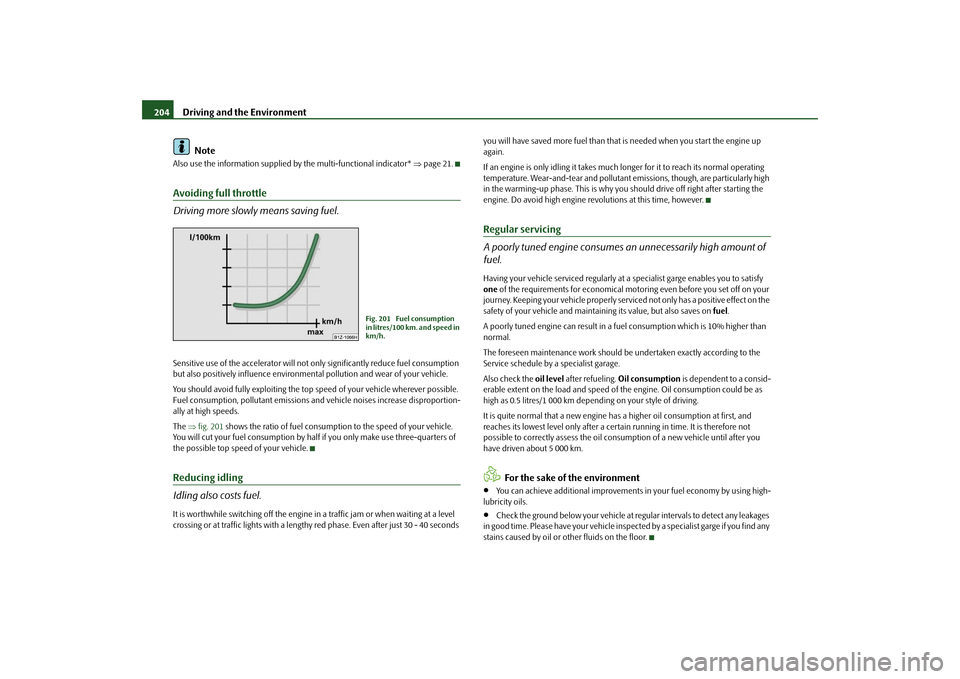
Driving and the Environment
204
Note
Also use the information supplied by the multi-functional indicator*
⇒page 21.
Avoiding full throttle Driving more slowly means saving fuel.Sensitive use of the accelera
tor will not only significantly reduce fuel consumption
but also positively influence environmen
tal pollution and wear of your vehicle.
You should avoid fully exploi
ting the top speed of your vehicle wherever possible.
Fuel consumption, pollutant emissions and vehicle noises increase disproportion- ally at high speeds. The
⇒fig. 201
shows the ratio of fuel consumption to the speed of your vehicle.
You will cut your fuel consumption by half
if you only make use three-quarters of
the possible top speed of your vehicle.Reducing idling Idling also costs fuel.It is worthwhile switching off the engine in
a traffic jam or when waiting at a level
crossing or at traffic lights with a length
y red phase. Even after just 30 - 40 seconds
you will have saved more fuel than that
is needed when you start the engine up
again. If an engine is only idling it takes much
longer for it to reach its normal operating
temperature. Wear-and-tear and pollutant emissions, though, are particularly high in the warming-up phase. This is why you
should drive off right after starting the
engine. Do avoid high engine re
volutions at this time, however.
Regular servicing A poorly tuned engine consumes an unnecessarily high amount of fuel.Having your vehicle serviced regularly at a specialist garge enables you to satisfy one
of the requirements for economical moto
ring even before you set off on your
journey. Keeping your vehicle properly servic
ed not only has a positive effect on the
safety of your vehicle and maintaining its value, but also saves on
fuel
.
A poorly tuned engine can result in a fu
el consumption which is 10% higher than
normal. The foreseen maintenance work should be undertaken exactly according to the Service schedule by a specialist garage. Also check the
oil level
after refueling.
Oil consumption
is dependent to a consid-
erable extent on the load and speed of
the engine. Oil consum
ption could be as
high as 0.5 litres/1 000 km depending on your style of driving. It is quite normal that a new engine ha
s a higher oil consumption at first, and
reaches its lowest level only
after a certain running in
time. It is therefore not
possible to correctly assess the oil cons
umption of a new vehicle until after you
have driven about 5 000 km.
For the sake of the environment
•
You can achieve additional improvements
in your fuel economy by using high-
lubricity oils.•
Check the ground below your vehicle at re
gular intervals to detect any leakages
in good time. Please have yo
ur vehicle inspected by a specialist garge if you find any
stains caused by oil or
other fluids on the floor.
Fig. 201 Fuel consumption in litres/100 km. and speed in km/h.
se0.1.book Page 204 Frida
y, April 10, 2009 3:19 PM
Page 229 of 304
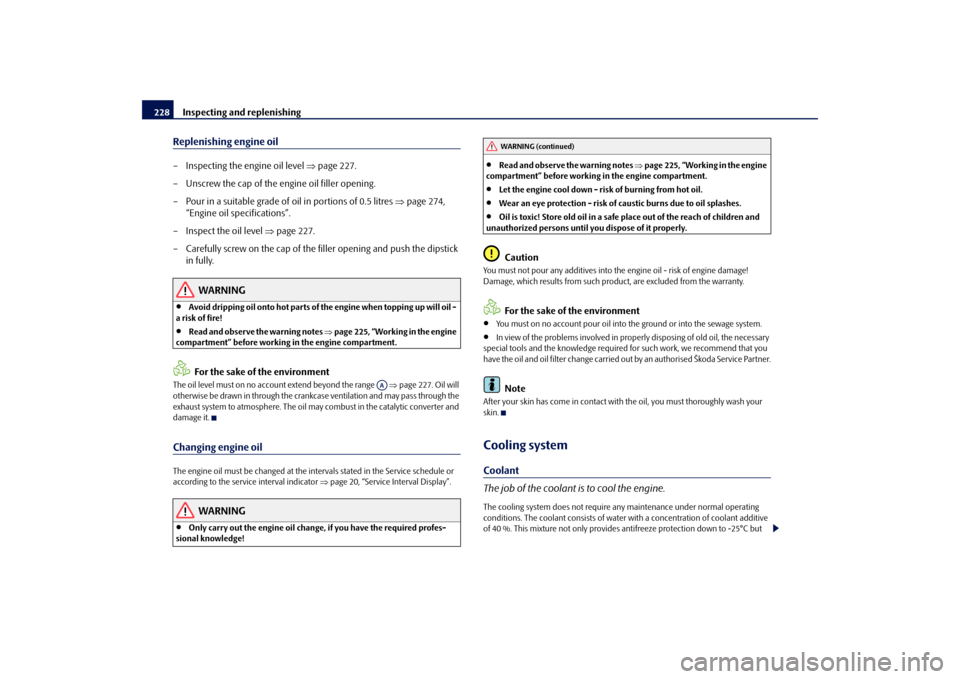
Inspecting and replenishing
228
Replenishing engine oil– Inspecting the engine oil level
⇒
page 227.
– Unscrew the cap of the engine oil filler opening. – Pour in a suitable grade of oil in portions of 0.5 litres
⇒
page 274,
“Engine oil specifications”.
– Inspect the oil level
⇒
page 227.
– Carefully screw on the cap of the
filler opening and push the dipstick
in fully.
WARNING
•
Avoid dripping oil onto hot parts of the engine when topping up will oil -
a risk of fire!•
Read and observe the warning notes
⇒page 225, “Working in the engine
compartment” before working in the engine compartment.
For the sake of the environment
The oil level must on no account extend beyond the range
⇒page 227. Oil will
otherwise be drawn in through the crankc
ase ventilation and may pass through the
exhaust system to atmosphere. The oil ma
y combust in the cata
lytic converter and
damage it.Changing engine oilThe engine oil must be changed at the intervals stated in the Service schedule or according to the service interval indicator
⇒page 20, “Service Interval Display”.
WARNING
•
Only carry out the engine oil change, if you have the required profes-
sional knowledge!
•
Read and observe the warning notes
⇒page 225, “Working in the engine
compartment” before working in the engine compartment.•
Let the engine cool down - risk of burning from hot oil.
•
Wear an eye protection - risk of caustic burns due to oil splashes.
•
Oil is toxic! Store old oil in a safe place out of the reach of children and
unauthorized persons until you dispose of it properly.
Caution
You must not pour any additives into th
e engine oil - risk of engine damage!
Damage, which results from such produc
t, are excluded from the warranty.
For the sake of the environment
•
You must on no account pour oil into
the ground or into the sewage system.
•
In view of the problems involved in prop
erly disposing of old oil, the necessary
special tools and the knowledge required for such work, we recommend that you have the oil and oil filter change carried out by an authorised Škoda Service Partner.
Note
After your skin has come in contact with the oil, you must thoroughly wash your skin.Cooling systemCoolant The job of the coolant is to cool the engine.The cooling system does not require an
y maintenance under normal operating
conditions. The coolant consis
ts of water with a concentration of coolant additive
of 40 %. This mixture not only provides
antifreeze protection down to -25°C but
AA
WARNING (continued)
se0.1.book Page 228 Frida
y, April 10, 2009 3:19 PM
Page 236 of 304
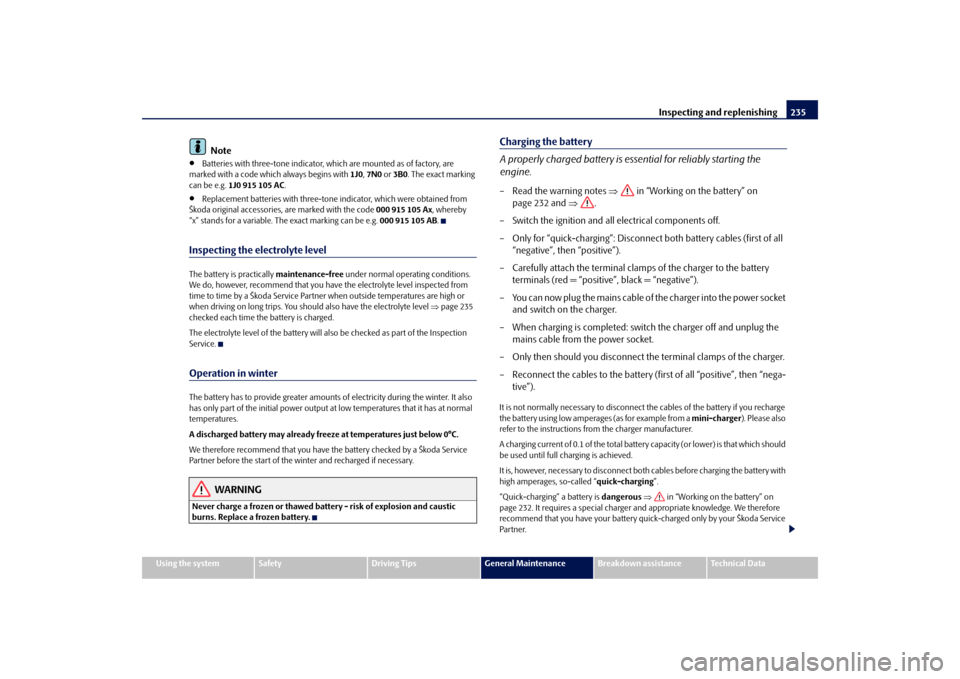
Inspecting and replenishing
235
Using the system
Safety
Driving Tips
General Maintenance
Breakdown assistance
Technical Data
Note
•
Batteries with three-tone indicator, which are mounted as of factory, are
marked with a code which always begins with
1J0
, 7N0
or 3B0
. The exact marking
can be e.g.
1J0 915 105 AC
.
•
Replacement batteries with three-tone
indicator, which were obtained from
Škoda original accessories, are marked with the code
000 915 105 Ax
, whereby
“x” stands for a variable. The exact marking can be e.g.
000 915 105 AB
.
Inspecting the electrolyte levelThe battery is practically
maintenance-free
under normal oper
ating conditions.
We do, however, recommend that you have
the electrolyte level inspected from
time to time by a Škoda Service Partner when outside temperatures are high or when driving on long trips. You should also have the electrolyte level
⇒page 235
checked each time the battery is charged. The electrolyte level of the battery will al
so be checked as part of the Inspection
Service.Operation in winterThe battery has to provide greater amounts of
electricity during the winter. It also
has only part of the initial power output at
low temperatures that it has at normal
temperatures. A discharged battery may already freez
e at temperatures just below 0°C.
We therefore recommend that you have the battery checked by a Škoda Service Partner before the start of the winter and recharged if necessary.
WARNING
Never charge a frozen or thawed battery - risk of explosion and caustic burns. Replace a frozen battery.
Charging the battery A properly charged battery is esse
ntial for reliably starting the
engine.– Read the warning notes
⇒
in “Working on the battery” on
page 232 and
⇒
.
– Switch the ignition and a
ll electrical components off.
– Only for “quick-charging”: Disconnect
both battery cables (first of all
“negative”, then “positive”).
– Carefully attach the terminal clamps of the charger to the battery
terminals (red = “positive”, black = “negative”).
– You can now plug the mains cable of
the charger into the power socket
and switch on the charger.
– When charging is completed: switch the charger off and unplug the
mains cable from the power socket.
– Only then should you disconnect the terminal clamps of the charger.– Reconnect the cables to the battery (first of all “positive”, then “nega-
tive”).
It is not normally necessary
to disconnect the cables of the battery if you recharge
the battery using low amperages (as for example from a
mini-charger
). Please also
refer to the instructions from the charger manufacturer. A charging current of 0.1 of the total battery
capacity (or lower)
is that which should
be used until full charging is achieved. It is, however, necess
ary to disconnect both cables be
fore charging the battery with
high amperages, so-called “
quick-charging
”.
“Quick-charging” a battery is
dangerous
⇒
in “Working on the battery” on
page 232. It requires a special charger and appropriate knowledge. We therefore recommend that you have your battery qu
ick-charged only by your Škoda Service
Par tner.
se0.1.book Page 235 Frida
y, April 10, 2009 3:19 PM
Page 237 of 304
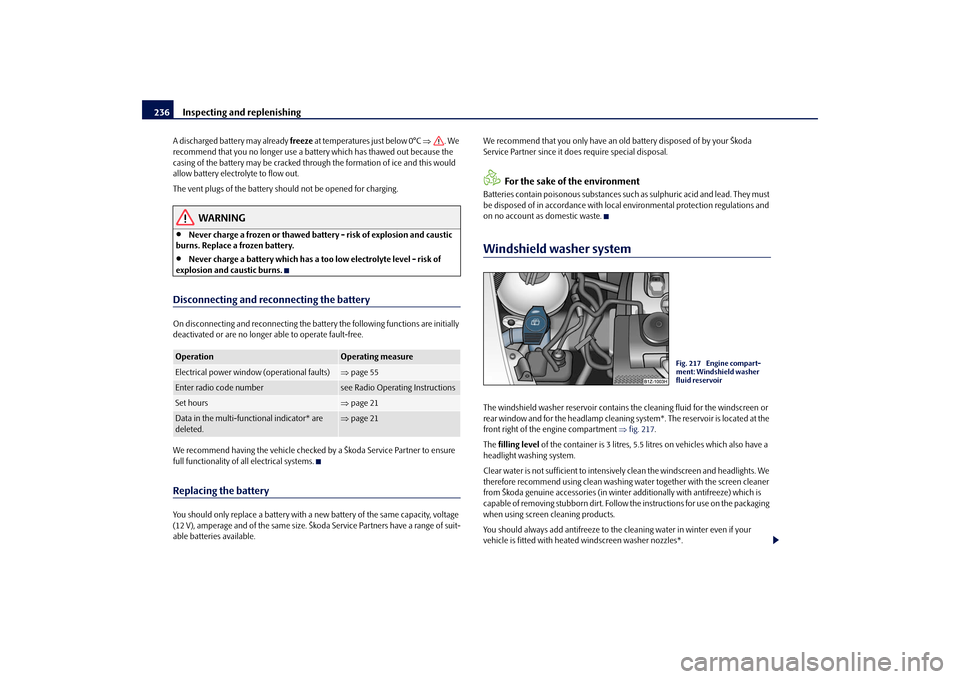
Inspecting and replenishing
236
A discharged battery may already
freeze
at temperatures just below 0°C
⇒
. We
recommend that you no longer use a ba
ttery which has thawed out because the
casing of the battery may be cracked thro
ugh the formation of ice and this would
allow battery electrolyte to flow out. The vent plugs of the battery should not be opened for charging.
WARNING
•
Never charge a frozen or thawed battery - risk of explosion and caustic
burns. Replace a frozen battery.•
Never charge a battery which has a to
o low electrolyte level - risk of
explosion and caustic burns.Disconnecting and reconnecting the batteryOn disconnecting and reconnecting the batte
ry the following functions are initially
deactivated or are no longer able to operate fault-free. We recommend having the vehicle checked
by a Škoda Service Partner to ensure
full functionality of all electrical systems.Replacing the batteryYou should only replace a battery with a
new battery of the same capacity, voltage
(12 V), amperage and of the same size. Škoda Service Partners have a range of suit- able batteries available.
We recommend that you only have an ol
d battery disposed of by your Škoda
Service Partner since it does require special disposal.
For the sake of the environment
Batteries contain poisonous substances such
as sulphuric acid and lead. They must
be disposed of in accordance with loca
l environmental protection regulations and
on no account as domestic waste.Windshield washer systemThe windshield washer reserv
oir contains the cl
eaning fluid for th
e windscreen or
rear window and for the headlamp cleaning system*. The reservoir is located at the front right of the engine compartment
⇒fig. 217
.
The
filling level
of the container is 3 litres, 5.5 li
tres on vehicles which also have a
headlight washing system. Clear water is not sufficient to intensively clean the windscreen and headlights. We therefore recommend using clean washing water together with the screen cleaner from Škoda genuine accessories (in winter
additionally with antifreeze) which is
capable of removing stubborn
dirt. Follow the instructio
ns for use on the packaging
when using screen cleaning products. You should always add antifreeze to the
cleaning water in winter even if your
vehicle is fitted with heated
windscreen washer nozzles*.
Operation
Operating measure
Electrical power window (operational faults)
⇒page 55
Enter radio code number
see Radio Operating Instructions
Set hours
⇒page 21
Data in the multi-functional indicator* are deleted.
⇒ page 21
Fig. 217 Engine compart- ment: Windshield washer fluid reservoir
se0.1.book Page 236 Frida
y, April 10, 2009 3:19 PM
Page 241 of 304
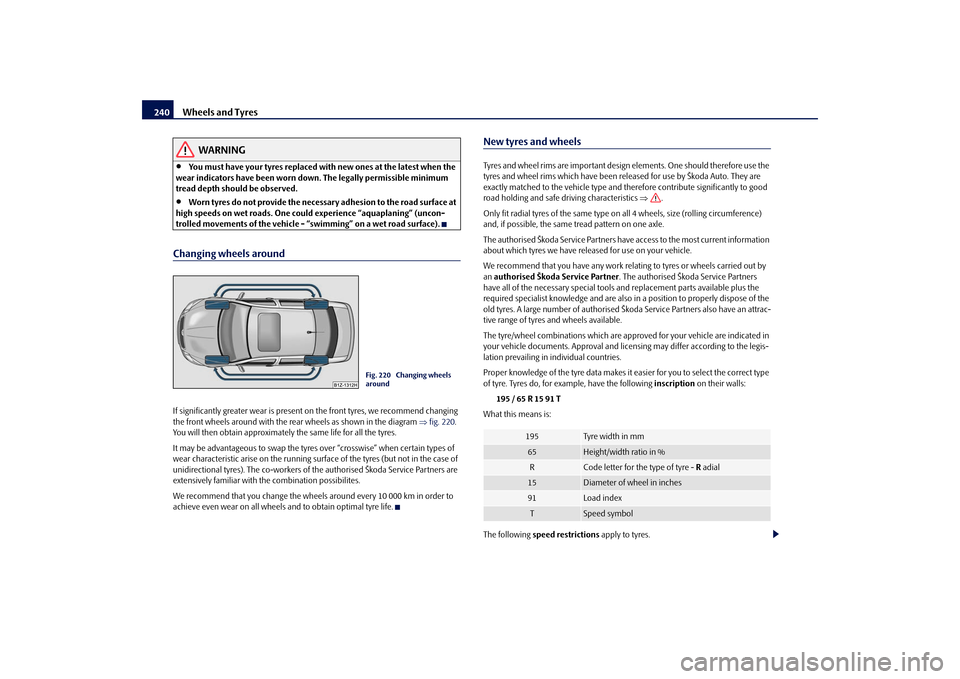
Wheels and Tyres
240
WARNING
•
You must have your tyres replaced with new ones at the latest when the
wear indicators have been worn do
wn. The legally permissible minimum
tread depth should be observed.•
Worn tyres do not provide the necessary adhesion to the road surface at
high speeds on wet roads. One could experience “aquaplaning” (uncon- trolled movements of the vehicle - “swimming” on a wet road surface).Changing wheels aroundIf significantly greater wear is present on
the front tyres, we recommend changing
the front wheels around with the rear wheels as shown in the diagram
⇒fig. 220
.
You will then obtain approximately the same life for all the tyres. It may be advantageous to swap the tyre
s over “crosswise” when certain types of
wear characteristic ar
ise on the running surface of the tyres (but not in the case of
unidirectional tyres). The co-workers of the authorised Škoda Service Partners are extensively familiar with the combination possibilites. We recommend that you change the wheels around every 10 000 km in order to achieve even wear on all wheels and to obtain optimal tyre life.
New tyres and wheelsTyres and wheel rims are important design elements. One should therefore use the tyres and wheel rims which have been re
leased for use by Škoda Auto. They are
exactly matched to the vehicle type and therefore contribute significantly to good road holding and safe driving characteristics
⇒
.
Only fit radial tyres of the same type on
all 4 wheels, size (rolling circumference)
and, if possible, the same tread pattern on one axle. The authorised Škoda Service Partners have access to the most current information about which tyres we have rele
ased for use on your vehicle.
We recommend that you have any work rela
ting to tyres or wheels carried out by
an authorised Škoda Service Partner
. The authorised Škoda Service Partners
have all of the nece
ssary special tools and replacem
ent parts available plus the
required specialist knowledge and are also in a position to properly dispose of the old tyres. A large number of authorised Škoda Service Partners also have an attrac- tive range of tyres and wheels available. The tyre/wheel combinations which are appr
oved for your vehicle are indicated in
your vehicle documents. Approval and lice
nsing may differ according to the legis-
lation prevailing in individual countries. Proper knowledge of the tyre data makes it easier for you to select the correct type of tyre. Tyres do, for exam
ple, have the following
inscription
on their walls:
195 / 65 R 15 91 T
What this means is: The following
speed restrictions
apply to tyres.
Fig. 220 Changing wheels around
195
Tyre w idt h in mm
65
Height/width ratio in %
R
Code letter for the type of tyre -
R adial
15
Diameter of wheel in inches
91
Load index
T
Speed symbol
se0.1.book Page 240 Frida
y, April 10, 2009 3:19 PM